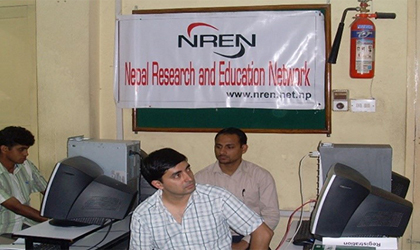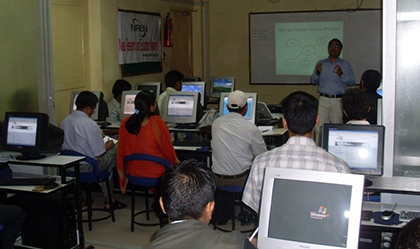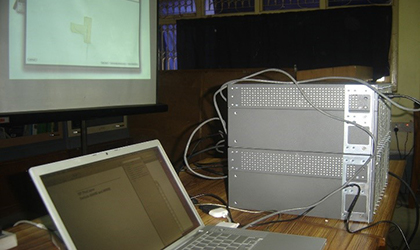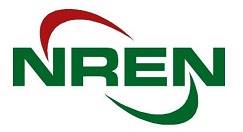Project leader: Prashant Manandhar / Gaurab Raj Upadhaya
Team members: Dr. Bhushan Raj Shrestha, Mahabir Pun, Indiver Badal and Rajan Parajuli
Fund from: Information Society Innovation Fund/NREN
Project Period: February 2009 – February 2010
The specific objectives were:
- To connect R&E network at 2 universities and 10 colleges.
- To develop technical human resources by providing technical training.
- To establish APAN network connectivity in Nepal.
- To upgrade bandwidth to at least 2 Mbps among NREN connected education institution.
- Provide AI3, APAN and TEIN3 network to the colleges connected with NREN.
- To encourage researchers to conduct advanced research and development.
In the first phase, 2 universities and 10 colleges were selected based on the existing network infrastructure, type of colleges and the number of total students.
Two days campus network worshop was organised,where twenty-three participants from different colleges were participated. The contents of the workshop were network planning and design, CIDR and routing basics, Cisco's router configuration, static routing, dynamic routing using OSPF, advanced routing tutorial, BGP basics, DNS setup and configuration and routing appliances.


3. Provider provisioning and building network
Negotiations were done with different network providers before selecting three providers for laying fiber and carrying NREN VLAN to the selected colleges. Those three network providers were World Link Communications, Subisu Cablenet and Websurfer Communications.
4. Arranged network equipments
HP Procurve switches, Linux based SMR routers as well as Cisco routers were distributed to the colleges selected by the project to upgrade network infrastructure. Network Startup Resource Centre (NSRC) and Packet Clearing House (PCH) had donated HP Procurve Switches and Access Routers repectively for this project. From that donation, some routers and switches were handovered to colleges on 1st May 2009. NREN technical team installed all the donated equipment in selected institutions. NREN also installed Cisco routers in various locations.


In July 2009, the NREN local network was connected with the APAN network through a tunnel. The bandwidth for the tunnel was donated by the Worldlink Communications as a resultmembers were able to utilize up to 10Mbps of bandwidth In January 2010, NREN was finally connected with the TEIN3 network at 45Mbps. All the selected education institutions were then connected to TEIN3.
The project was able to achieve the following outputs:
- Capacity building of network engineers
Total 25 network engineers were trained on campus network workshop . Campus network workshop covered knowledge relates to network planning and design, routing, DNS setup and configuration, BGP and routing appliances The training enhanced the technical capabilities of participants. Therefore after completion of workshop they were able to handle their local network independently.
- Network capacity building of participating institutions
The devices distributed by the project improved the existing network performance and helped troubleshoot network irregularity. HP Procurve network switch containing 56 ports (upgrade up to 80 ports) gave the wide access as well as helped in managing their necessities.
- Optical fiber connectivity
The network infrastructure survey of different collges during the project revealed that majority of the colleges had no prior fiber link, and they used the Internet through wireless or ADSL. The fiber links provided by the project broadened its facilities and the services as well improved the network speed of the NREN member institutions.
- International bandwidth upgrade
One of our service providers donated 10Mbps of Internet connectivity to enhance the project through which we succeeded to created a tunnel to the international APAN network.
- International R&E connectivity
The network was built to facilitate the international connectivity provided by the TEIN3 project, AI3 and APAN to the members and all new prospective members to utilize the international R&E network.
- New model for R&E networks
One of the main achievements of this project was implementing R&E network in a country with public-private partnership. In most cases, so far, such networks have been built by government efforts or substantial government investment, whereas in the case of Nepal, the network has been built with contributions from the beneficiary members as well as donations and special consideration i.e. price wise by network service providers. This more business-like venture may be a model for implementing R&E network to other countries.
Problems Faced
Few problems were faced while implementating the project, which were:
- Unawareness about the benefits of R&E Networks
This was the main problem faced as it was very difficult to make people/institution understand the benefit of connecting with NREN. Since people compared us with ISP’s, we tried to address this by a high-level discussion and presentations to the management of colleges and universities.
- ‘Chicken and Egg’ situation with ‘local network buildout vs. international R&E connectivity’It was difficult to build a local network without any special connection to the international R&E Network. Similarly, without the local network it was not very fruitful to connect to the international network. We solved this by tunneling from the local network core to the APAN on a temporary basis which was solved permanently after the TEIN3 connectivity in Nepal.
- Technical difficulties in forming interconnected networks
The administration and the technical team encountered some difficulties during fiber installation and IP renumbering efforts. All of the colleges were using IP starting from 192.168., so it took nearly two months to replace with new IP address. There were also technical problems with inappropriate equipment and need to procure things in the colleges. None of the problems was of insurmountable types.Of the above, the first problem was acute. While there were some institutions that appreciate the value of the high-speed network, most were not able to differentiate it with the regular Internet. As the Internet has grown prevalent in the last many years, there are limited resources accessible over the R&E network fabric but not over the regular Internet. In this case, some institutions perceive us to be just another ISP network, whereas some see us as an ‘incomplete’ entity as we cannot provide access to the Internet. While this hurdle has forced us to re-think our strategy of not providing Internet access to members, we continue to try to convince and demonstrate the benefits of the network to the members and prospective members. We have been studying efforts in many other countries how this can be undertaken. Video conferencing, teleteaching sessions, virtual classes access to restricted materials on the different academic websites can be useful resources for NREN.
